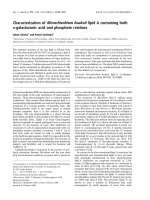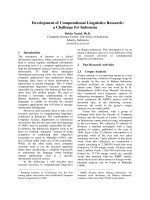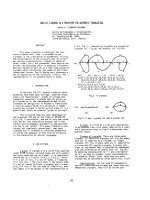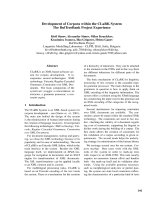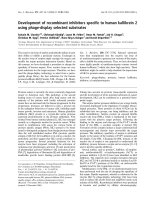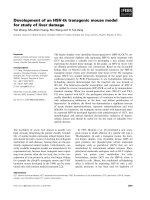Báo cáo khoa học: "Development of Computational Linguistics Research: a Challenge for Indonesia" pptx
Bạn đang xem bản rút gọn của tài liệu. Xem và tải ngay bản đầy đủ của tài liệu tại đây (15.92 KB, 2 trang )
Development of Computational Linguistics Research:
a Challenge for Indonesia
Bobby Nazief, Ph.D.
Computer Science Center, University of Indonesia
Jakarta, Indonesia
1 Introduction
The emergence of Internet as a global
information repository, where information of all
kind is stored, requires intelligent information
processing tools (i.e., computer applications) to
help the information seeker to retrieve the stored
information. To build these intelligent
information processing tools, we need to build
computer applications that understand human
language since most of those information is
represented in human language. This is where
computational linguistics becomes important,
especially for countries like Indonesia that hosts
more than 200 million people. We need to
develop a systematic understanding of the
Bahasa Indonesia (the Indonesian national
language) to enable us develop the needed
computer applications that will help us manage
information intelligently.
However, until recently, there is only a few
research activities in computational linguistics
conducted in Indonesia. The establishment of
Computer Science departments in Indonesian
universities that did not start until the beginning
of 1980’s may be partially responsible for this
1
.
In addition, the Indonesian linguists seem to be
keen on working “manually” instead of using
computers in conducting their linguistics
researches as stated in Muhadjir (1995), only
few of them really make use of the technology.
While, on the other hand, most computer
scientists tend to use the practical approach
rather than constructing a complete framework
to understand the language when building
related applications such as a specific
information retrieval system.
In the following, I will describe past
research activities in computational linguistics
1
Bandung Institute of Technology was the first
among public universities that established Computer
Science department in 1980.
on Bahasa Indonesia. This description is by no
means exhaustive since it is very difficult to find
out research activities in computational
linguistics in Indonesia.
2 Past Research Activities
2.1 Corpus Analysis
Corpus analysis is an important means as a way
to understand the evolution of language usage by
its people. In the case of Bahasa Indonesia,
research activities on corpus analysis were
almost none. There was one work by R. R.
Hardjadibrata (1969) from Monash University,
who conducted word frequency analysis of
Indonesian newspapers. There was also similar
work conducted the MMTS project (will be
described later, in the following section);
however, the result of the group’s corpus
analysis was not made public.
Given this condition, with a group of
colleague both from the Faculty of Computer
Science and the Faculty of Letters, I conducted
an Indonesian corpus analysis using newspapers
as the text source. We collected 52 editions of
Kompas, a national newspaper with a large
number of readers, published in the year of
1994. Each of the 52 editions corresponds to a
particular week of the year and was taken
randomly from the 7 daily editions of that given
week. From this collection, we constructed a
corpus consisting of 2.200.818 words that were
formed by 74.559 unique words. Of these more
than 2 million words, 1.826.740 words that were
formed by 27.738 unique words are actually
words that matched with the KBBI
2
entries,
while the rest are either names or foreign words.
Detailed analysis can be found in Muhadjir
(1996).
2
KBBI (Kamus Besar Bahasa Indonesia), the
standard word dictionary for Bahasa Indonesia,
contains a little more than 70.000 word entries.
2.2 Morphological Analysis
Everyone who has used a word processor
understands the importance of a spelling checker
in helping him/her to produce an error-free
document. To develop a spelling checker, we
need to understand the morphological structure
of words especially how derived-words are
constructed from their root-words and the
addition of affixes.
We have conducted research to analyze the
morphological structure of Indonesian words
and based on this analysis we have developed a
stemming algorithm suitable for those words.
Unlike English, where the role of suffix
dominates the generation of derived-words,
Bahasa Indonesia depends on both prefix and
suffix to derive new words. Therefore, to stem a
derived Indonesian word in order to obtain its
root-word, we have to look at the presence of
both prefix and suffix in that derived-word
(Nazief, 1996). In addition, similar to English,
multiple suffixes can also be present on a given
derived-word.
Based on this stemming algorithm, we have
developed a spelling checker and spelling-error
corrector utilities as part of the Lotus
Smartsuite
3
package.
2.3 The MMTS Project
One notable research activity among the
few computational linguistics research activities
in Indonesia is the Multilingual Machine
Translation System (MMTS) project conducted
by the Agency for Assessment and Application
of Technology (BPPT) as part of multi-national
research project between China, Indonesia,
Malaysia, Thailand, and lead by Japan (see
/>ct/mt/mt.htm, />Unfortunately, there are very few publications
about this work that could have benefited the
computational linguistic community in the
country. One of the few publications that the
MMTS project made available for public is the
Indonesian Word Electronic Dictionary (KEBI),
which could be accessed on-line on
The dictionary contains
3
Lotus Smartsuite is an office automation package
consisting word processor, spreadsheet, presentation
editor, and database applications developed by Lotus
Development Corporation.
22.500 root-word and 43.500 derived-word
entries.
3 Understanding Indonesian Grammar
Currently, I am concentrating my work on
developing syntax analyzer for sentences written
in Bahasa Indonesia. The approach taken
initially was to use the context free grammar
with restriction such as that used in the linguistic
string analysis (Sager, 1981). Using this
approach, we have developed grammar that
understands declarative sentences (Shavitri,
1999). However, our experience shows that we
need to have a more detailed word categories
than is currently available in the standard
Indonesian word dictionary (KBBI) before the
grammar can be used effectively.
This finding really shows us the importance
of collaborating with the linguists who
understand this field better. But before we do
this, we need to educate our linguist-fellows the
importance of computer in their fields.
4 Acknowledgements
I would like to thank Mirna, bu Multamia,
pak Muhadjir, bu Kiswartini, and all of my
students who have collaborated with me in these
efforts to understand Bahasa Indonesia better.
5 References
R. R. Hardjadibrata (1969) An Indonesian Newspaper
Wordcount. Department of Indonesian and Malay,
Faculty of Arts, Monash University, Cayton,
Victoria.
Muhadjir (1995) Menjaring Data dari Teks.
Lembaran Sastra Universitas Indonesia, edisi
khusus:Tautan Sastra & Komputer, Faculty of
Letters, University of Indonesia, Depok, pp. 81 91.
Muhadjir, et. al. (1996) Frekuensi Kosakata Bahasa
Indonesia. Faculty of Letters, University of
Indonesia, Depok, 207 p.
Bobby A. A. Nazief and Mirna Adriani (1996) Confix
Stripping: Approach to Stemming Algorithm for
Bahasa Indonesia. Internal publication. Faculty of
Computer Science, University of Indonesia, Depok.
Naomi Sager (1981) Natural Language Information
Processing: A Computer Grammar of English and
Its Aplications. Addison-Wesley Publishing
Company, Massachusetts.
Shelly Shavitri (1999) Analisa Struktur Kalimat
Bahasa Indonesia dengan Menggunakan Pengurai
Kalimat Berbasis Linguistic String Analysis.
Bachelor’s Thesis. Faculty of Computer Science,
University of Indonesia, Depok, 88 p.

